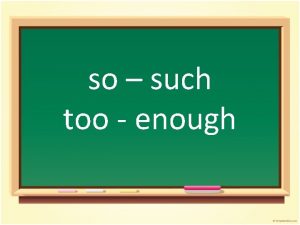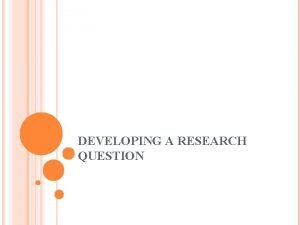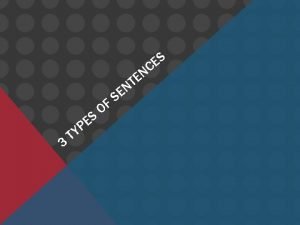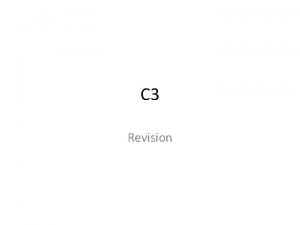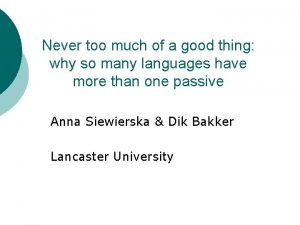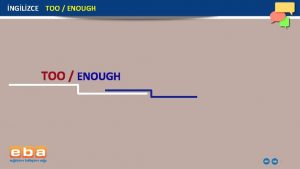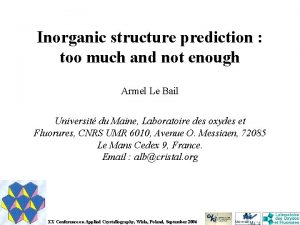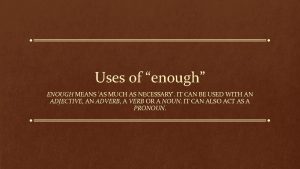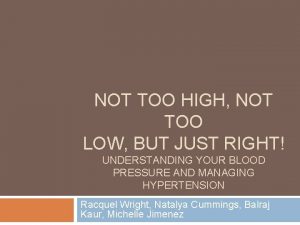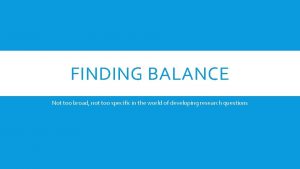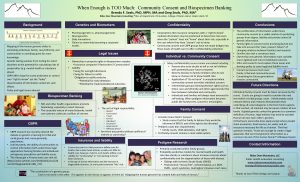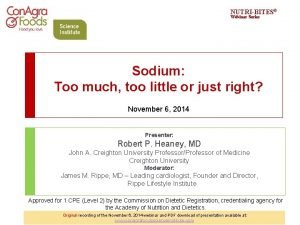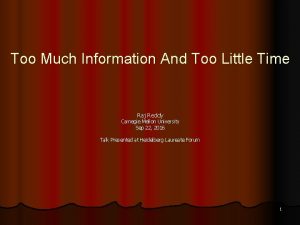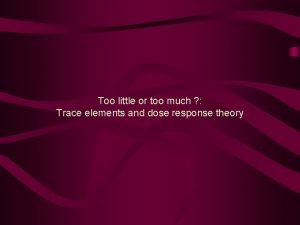When is Too Much Not Enough Using Cognitive



























- Slides: 27

When is Too Much Not Enough? Using Cognitive Theories of Learning to Shape Instructional Choices Michael S. Kirkpatrick May 10, 2017 JMU CFI May Symposium 2017 Dr. Michael S. Kirkpatrick

What is “learning? ” JMU CFI May Symposium 2017 Dr. Michael S. Kirkpatrick

Einstellung Sample A B 29 3 Einstellung 1 21 Einstellung 2 14 Einstellung 3 18 Einstellung 4 9 Einstellung 5 Critical 1 127 C 20 3 Solution 163 Explanation: 25 29 - 3 - 3 = 20 127 -21 -3 -3 100 163 -14 -2525 43 -18 -1099 10 42 -9 -6 -6 43 10 5 42 6 21 49 -23 -3 -3 Experimental Solution: - C = Target 4 20 B - A - C 59 23 Target 49 3 59 -20 -4 -4 39 -15 -3 -3 31 48 -18 -4 -4 20 36 -14 -8 -8 J. D. Bransford Mind, Experience, and Criticalet 2 al. , How People 15 Learn: Brain, 39 3 School. National 18 Academy Press. 2000. https: //www. nap. edu/catalog/9853/how-people-learn-brain-mind-experience-and-school-expanded-edition Critical 3 18 48 4 22 JMU CFI May Symposium 2017 Dr. Michael S. Kirkpatrick Critical 4 14 36 8 6

Einstellung A B Sample 29 3 Einstellung 1 21 127 C Target 20 3 100 Einstellung Solution: Einstellung 14 2 - 23 - 3 = 20 49 Direct Solution: 25 99 23 - 3 = 20 163 Einstellung 3 18 43 10 5 Einstellung 4 9 42 6 21 Einstellung 5 20 59 4 31 Critical 1 23 49 3 20 J. D. Bransford Mind, Experience, and Criticalet 2 al. , How People 15 Learn: Brain, 39 3 School. National 18 Academy Press. 2000. https: //www. nap. edu/catalog/9853/how-people-learn-brain-mind-experience-and-school-expanded-edition Critical 3 18 48 4 22 JMU CFI May Symposium 2017 Dr. Michael S. Kirkpatrick Critical 4 14 36 8 6

Einstellung (percent) Direct (percent) No solution (percent) Control (children) 1 89 10 Experimental (children) 72 24 4 Control (adults) 0 100 0 Experimental (adults) 74 26 0 J. D. Bransford et al. , How People Learn: Brain, Mind, Experience, and School. National Academy Press. 2000. https: //www. nap. edu/catalog/9853/how-people-learn-brain-mind-experience-and-school-expanded-edition JMU CFI May Symposium 2017 Dr. Michael S. Kirkpatrick

Branches of Educational Psychology Behavioral Cognitive (Skinner) (Bjork, Sweller) Constructivis m (Vygotsky, Bruner) JMU CFI May Symposium 2017 Dr. Michael S. Kirkpatrick Development al (Piaget)

Learning is… Knowledge Factual knowledge Change Context Area of inquiry Attitudes Feedback Retrieval Application Abilities Metacognitio n Progress Practice JMU CFI May Symposium 2017 Dr. Michael S. Kirkpatrick

Learning is…misunderstood Common myths about learning: • Good learning makes us feeling confident and clear. • Learning is aware and purposeful. • Getting emotional interferes with learning. • You have to be interested to learn. • Intelligent people learn more easily. • Learning style adaptations are helpful. • Rereading texts is helpful. • Learning is learning. M. Pasupathi, How We Learn. The Great Courses. Chantilly, VA, USA: The Teaching Company, 2012. P. Brown, H. Roediger, and M. Mc. Daniel, Make It Stick : The Science of Successful Learning. JMU CFICambridge, May Symposium. MA, 2017 USA: Harvard University Press, 2014. Dr. Michael S. Kirkpatrick

In-class Physics Demos The evidence supporting active learning suggests that passive engagement with information can contribute to reinforcing misconceptions. One study examined how effective in-class physics demonstrations were in helping to understand concepts. All students began with a reading assignment. Some students then took part in an inclass demonstration; the control group did not observe or take part in a demonstration. The students completed a short test to conclude the experiment. Which group did the worst on the posttest, missing the most points? JMU CFI May Symposium 2017 Dr. Michael S. Kirkpatrick

In-class Physics Demos Which group did the worst on the post-test, missing the most points? (A) Students who did not observe a demo (control group) (B) Students who only observed the demo (C) Students who predicted the outcome before it occurred by writing down a guess (D) Students who discussed the outcome with peers after observing what occurred E. Mazur, Keynote address at ICER 2011. https: //computinged. wordpress. com/2011/08/17/eric-mazurs-keynote-at-icer-2011 -observing-demos-hurts-learningand-confusion-is-a-sign-of-understanding/ JMU CFI May Symposium 2017 Dr. Michael S. Kirkpatrick

Knowledge and human cognitive architecture JMU CFI May Symposium 2017 Dr. Michael S. Kirkpatrick

Types of Knowledge Biologically Primary ✕ ✓ JMU CFI May Symposium 2017 Dr. Michael S. Kirkpatrick Biologically Secondary ✕ ✓

Retrieval Fluency J. D. Bransford et al. , How People Learn: Brain, Mind, Experience, and School. National Academy Press. 2000. https: //www. nap. edu/catalog/9853/how-people-learn-brain-mind-experience-and-school-expanded-edition JMU CFI May Symposium 2017 Dr. Michael S. Kirkpatrick

Far transfer 90 ft 90 ft x 90 ft In a baseball diamond, the distance Apply the Pythagorean between each base is 90 ft. Which of theorem to the above the following is true about the shortest triangle to find the value distance between 1 st and 3 rd bases (the red line shown above)? of x. 1. It is less than 90 ft. 2. It is between 90 and 180 ft. 3. It is greater than 180 ft. 2017 May CFI Symposium JMU Dr. Sanjay Gupta is Cool

Memory Architecture JMU CFI May Symposium 2017 Dr. Michael S. Kirkpatrick

Human Cognitive Central Architecture Working executive memory Amassing Acquiring Information store Borrowing/ reorganizin g Randomnes s as genesis Interaction Narrow limits of change Environment al linking JMU CFI May Symposium 2017 Dr. Michael S. Kirkpatrick Auditory loop Visual. WM Capacity: spatial 4 -7 items (2 -3 novel) 20 seconds maximum Long-term memory

Key findings What works: What doesn’t: • Deliberative effort • Massed practice • Interleaved and spaced practice • Rereading texts • Learning style adaptations • Intuitive judgments • Try to solve problem before being taught • Testing as calibration • Pre-learning foundation • Elaborative encoding P. Brown, H. Roediger, and M. Mc. Daniel, Make It Stick : The Science of Successful Learning. Cambridge, MA, USA: Harvard University Press, 2014. JMU CFI May Symposium 2017 Dr. Michael S. Kirkpatrick

Cognitive load theory and its effects JMU CFI May Symposium 2017 Dr. Michael S. Kirkpatrick

Cognitive Load Theory Extraneous Load High Intrinsic Load Low Intrinsic Load Germane Load Goal-free effect Modality effect Worked example effect Imagination effect Variability effect A Transient info effect Redundancy effect B C JMU CFI May Symposium 2017 Dr. Michael S. Kirkpatrick D E

Worked example Step 1: Identify the shapes There are two right triangles with sides that are 90 ft and the red line as hypotenuse. 90 ft Step 2: Recall the formula Pythagorean theorem: a 2 + b 2 = c 2 Step 3: Substitute known values 902 + 902 = c 2 Step 4: Solve for c 8100 + 8100 = c 2 16, 200 = c 2 sqrt(16, 200) = sqrt(c 2) 90 sqrt(2) = c Step 5: Make a selection Since 1 < sqrt(2) < 2, 90 < c < 180, so the correct answer is (2) between 90 and 180 ft. JMU CFI May Symposium 2017 Dr. Michael S. Kirkpatrick In a baseball diamond, the distance between each base is 90 ft. Which of the following is true about the shortest distance between 1 st and 3 rd bases (the red line shown above)? 1. It is less than 90 ft. 2. It is between 90 and 180 ft. 3. It is greater than 180 ft.

Variability effect Calculate distance between (1, 1) and (4, 5) Step 1: Identify the facts Distance is the length of a hypotenuse, for a triangle with sides as the change in x and the change in y. Step 2: Recall the formula Pythagorean theorem: a 2 + b 2 = c 2 Step 3: Substitute known values (4 -1)2 + (5 -1)2 = c 2 Step 4: Solve for c 32 + 4 2 = c 2 9 + 16 = c 2 25 = c 2 5=c JMU CFI May Symposium 2017 Dr. Michael S. Kirkpatrick Low variability: Find distance between (2, 3) and (8, 11). Medium variability: Find distance between (2, 1) and (x, 13). High variability: Find (x, y) that has distance of 5 from (3, 4).

Redundancy Effect The redundancy effect occurs when information is presented in a way that includes redundant material. One example of this is to present the same idea using both visual and executive modalities, such as reading from a Power. Point slide that has a lot of text on it. The text itself is processed initially as visual imagery, then as auditory as we “read aloud” to ourselves internally. This induces extraneous cognitive load as our minds have to crossreference three forms to make sure they are the same. The effect is made worse when the instructor’s voice is also reading the words. Those words must also be crosschecked for accuracy. In the end, the information is lost before it can be transferred to LTM. JMU CFI May Symposium 2017 Dr. Michael S. Kirkpatrick

Notice anything? JMU CFI May Symposium 2017 Dr. Michael S. Kirkpatrick

Redundancy Effect The redundancy effect occurs when information is presented in a way that includes redundant material. One example of this is to present the same idea using both visual and executive modalities, such as reading from a Power. Point slide that has a lot of text on it. The text itself is processed initially as visual imagery, then as auditory as we “read aloud” to ourselves internally. This induces extraneous cognitive load as our minds have to crossreference three forms to make sure they are the same. The effect is made worse when the instructor’s voice is also reading the words. Those words must also be cross-checked for accuracy. In the end, the information is lost before it can be transferred to LTM. JMU CFI May Symposium 2017 Dr. Michael S. Kirkpatrick

Applications of effects Testing effect Goal-free effect Worked example effect Modality effect Variability effect Redundancy effect JMU CFI May Symposium 2017 Dr. Michael S. Kirkpatrick Imagination effect Transient info effect

Expertise reversal and guidance fading effects JMU CFI May Symposium 2017 Dr. Michael S. Kirkpatrick

Questions? JMU CFI May Symposium 2017 Dr. Michael S. Kirkpatrick
 Kahoot enough too
Kahoot enough too A lot of vs lots of
A lot of vs lots of Security is always excessive until it's not enough
Security is always excessive until it's not enough Being too broad
Being too broad Just about right scale
Just about right scale Högkonjuktur inflation
Högkonjuktur inflation How much caffeine is too much
How much caffeine is too much How much is too much plagiarism
How much is too much plagiarism Our failing schools enough is enough
Our failing schools enough is enough Im good enough i'm smart enough
Im good enough i'm smart enough Our failing schools enough is enough summary
Our failing schools enough is enough summary No quiz today
No quiz today So such too enough
So such too enough Too broad and too narrow examples
Too broad and too narrow examples Example of rationale
Example of rationale Too broad and too narrow examples
Too broad and too narrow examples So here you are too foreign for home
So here you are too foreign for home Too anointed to be disappointed
Too anointed to be disappointed Cognitive and non cognitive religious language
Cognitive and non cognitive religious language The world is too much with us analysis
The world is too much with us analysis The world is too much with us william wordsworth analysis
The world is too much with us william wordsworth analysis The world is too much with us paraphrase
The world is too much with us paraphrase Megan and ron ate too much and felt sick
Megan and ron ate too much and felt sick Too much vertical angulation results in images that are:
Too much vertical angulation results in images that are: Deacon process
Deacon process Similes in romeo and juliet act 1, scene 5
Similes in romeo and juliet act 1, scene 5 Never too much of a good thing
Never too much of a good thing Cause and effect conclusion
Cause and effect conclusion












